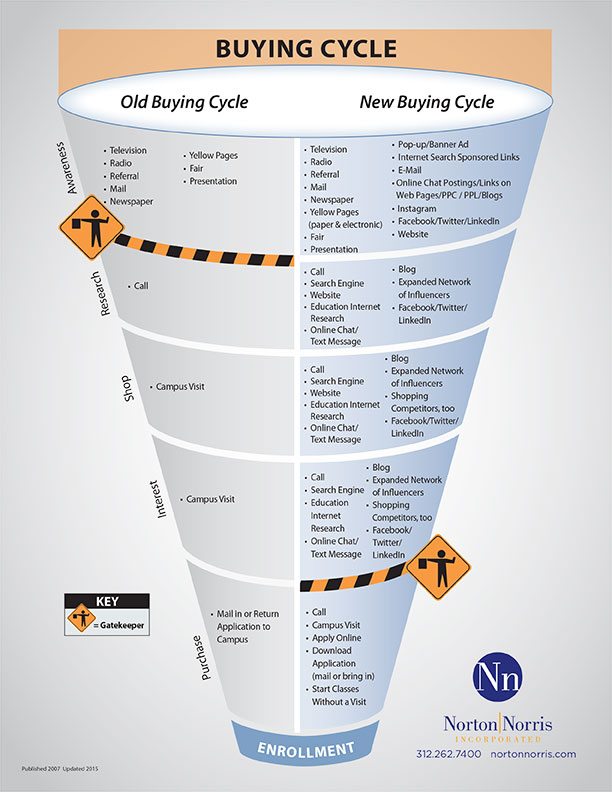The Case of the Mysterious Vanishing Inquiry
First of all – you have witnessed this phenomenon already. If you work at a school or college that is enrollment driven – and if you compare inquires received year over year – you have already noticed the decline. But instead of stepping back and watching what is really happening, you’ve probably circled the wagons and desperately tried to make your advertising dollars work better. Right? You challenge your internal marketing teams to message better and buy more efficiently. And your external agency is always under attack – with most conversations starting and centering on the need for more inquiries.
But have you ever stepped back and asked: “Why is this happening?” Or asked: “Why are we getting less inquiries?” Watch this video clip for one explanation…
Prediction: Inquiries Will go Away | Norton Norris
For years our sector of education has relied on inquiries. Our models were built on the need for large quantities of prospective students. This volume fuels an admissions machine that often includes a robust CRM or SIS for tracking inquiries and even using predictive modeling to determine the likelihood of enrollment.
Meanwhile, many large metropolitan areas have witnessed schools closing, or specific programs have been “taught out” resulting in less options for students. Often a client will call me with a level of excitement and anticipation after hearing the news of a teach-out or closing – thinking their inquiries and enrollments will increase, now that there is less competition and program availability has decreased. But it doesn’t happen. Inquiries and enrollments do not increase. Why is that?
Another Viewpoint
Let’s start by asking another question: “Why do you need to fill out a form in order to get information?” The information is on the web site already, right? You can visit any school web site and find fees, graduation rates, loan repayment, a net price calculator, and percentages of students who went to work… it’s all there on the web site.
And the wealth of information available doesn’t stop there. What about the college scorecard? Our government now compiles stats and makes comparisons readily available at: CollegeScoreCard.ed.gov
Perhaps we need to back up. Getting more information or requesting something in the mail is a practice that precedes the internet – when information was guarded and not generally available. To gather research, learn more and inform your buying decision, you looked for catalogs, view books, program slicks, etc. Remember when the common question on the phone was “can’t you send me a catalog?”
So we all know that day is over. Why do we still expect prospective students to complete a form, call, or request more information? We are living in the past and afraid to accept and embrace the change that technology has forced upon us.
If misery loves comfort – then enrollment managers may want to hang out with automobile manufacturers and dealers. The automotive industry has watched similar trends – with decreased test drives and dealer visits as more customers turn to the internet to research their car buy. According to a recent article from DMEautomotive* – one in six buyers skip the test drive altogether and nearly half of car buyers only visit one (or no) dealership prior to their purchase. The same article explains that four of five people rely on the internet for car buying and visit 10 websites in the process. And I bet they aren’t requesting information when they visit the sites!
Another research study from the McKinsey Report** has slightly different numbers – and claims that on average automobile buyers visit 1.6 dealerships – but what is alarming is by comparison, 10 years ago the average buyer visited 5 dealerships.
What parallel do we see with car buying and school research? Simple: The abundance of information on the internet. Buyers today understand they no longer need to visit dealerships and collect information or drive cars. Their shopping experience can be done safely and comfortably from their home or office – and when they are ready to buy they know where to go.
Meanwhile, back at our schools we still want inquiries and we still expect students to visit our school in order to make an enrollment decision.
Almost 10 years ago my business partner created the “new enrollment funnel” that appears below. The funnel starts to explain more of the reasons why inquiries have decreased and will continue to decrease – as the prospective student can move from the top of the funnel to the ultimate decision on their own. It’s not necessary for them to submit an information request and reveal their identity. Nope. They can proceed down the buying path on their terms. And then when they are ready to buy, they can identify themselves.

At traditional colleges and universities, this process is labeled “Stealth Applications.” That’s the terminology used to describe matriculates that never made an inquiry, and just proceeded to the application over requesting more information. Which seems pretty logical to me. Think about it. Who wants to get on a list and get calls, emails and text messages? I’m guessing as you read this you can re-call a recent experience where you or a friend reached out for more information – only to have your phone blow up. Maybe it was an on-line mortgage calculator. Or possibly you were exploring insurance alternatives.
The point is: Consumers are aware that when you register for that free app, or identify yourself to download a 30-day trial – you will be labeled as a “prospect.” You’ll receive emails. You’ll get newsletters. Catalogs may show up in the mail. And sales people will call.
So instead of registering and asking for more information – our future students can avoid the “prospect” stage – and safely lurk in the shadows as a “suspect.” They can look for reviews, do comparison shopping and more – without identifying themselves. And when they are ready to take the next step and begin the enrollment process they can complete an online application. Or can they? Does your web site have an online application? Is it a real application that a student can start, save and come back to? Is it user friendly? Mobile friendly?
If you are a “career school” looking to replace some of that decline of inquiries you have experienced – you might just do that with an effective on-line application. But that’s another topic for another blog.
You don’t need to register anyplace to read my blog – or any other blog or post from Norton|Norris. You can just visit the web site poke around, watch a video or two, read past articles we’ve written, etc. And when your curiosity has been satisfied and you want to take the next step you can call or email.
In closing, enjoy inquiries while you have them. Know that leads are decreasing and there are ways to optimize what you already have, and allow prospects a better buying process. You should start planning for “doomsday” when you no longer have a database of prospects now. I’m not certain when “doomsday” occurs, but it’s coming.
Sources:
*1 in 6 Car Buyers Skips Test-Drive; Nearly Half Visit Just One (Or No) Dealership Prior to Purchase
April 15, 2014
https://www.dmeautomotive.com/announcements/1-in-6-car-buyers-skips-test-drive-nearly-half-visit-just-one-or-no-dealership-prior-to-purchase#.V6HHiz86LE8
**McKinsey Report 2/2014



Leave A Comment